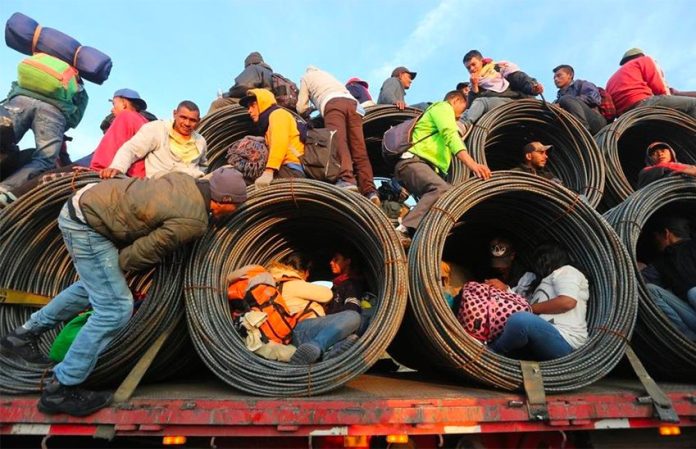Central Americans traveling as part of the first migrant caravan began to split into smaller groups after leaving Mexico City Saturday as they travel towards the Mexico-United States border at Tijuana.
Some members of the caravan, made up mainly of Hondurans fleeing poverty and violence, reached as far north as Culiacán, Sinaloa, yesterday after arriving in Guadalajara, Jalisco, the day before.
Approximately 1,100 more migrants reached the Jalisco capital yesterday afternoon.
However, the largest caravan contingent, estimated to number 2,500, has traveled at a slower pace and arrived in Guanajuato yesterday from Querétaro.
Most stayed at a shelter in Irapuato last night and today are attempting to hitch rides to Guadalajara, about 240 kilometers to the west.
Early yesterday morning, authorities in Jalisco transported around 400 migrants to federal highway 15D so they could hitch rides towards Mazatlán, Sinaloa, after spending Saturday night in an auditorium in Zapopan.
When they reached Tepic, Nayarit, state police, acting on orders from Governor Antonio Echevarría, rounded up the migrants and offered them transportation in buses to the border with Sinaloa.
From there, some reached Culiacán, which is still more than 1,500 kilometers from the border crossing between Tijuana and San Diego, California.
Members of the first caravan have now spent almost a month on the road after leaving Honduras on October 13.
While in southern Mexico, many migrants walked long distances between towns but they are now relying on hitching rides in all manner of transport to accelerate their journey towards the United States.
Migrants traveled on one truck intended to transport pigs and another carrying coffins, the Associated Press reported.
A request last week to the United Nations for bus transportation to the border from Mexico City was declined.
Authorities in Querétaro said that 6,531 migrants traveled through the state over the weekend.
Early yesterday, large groups of migrants arrived at the toll gates at the entry to the Querétaro-Celaya highway, where caravan leaders ordered that families be given priority to board passing trucks offering rides.
Hundreds of kilometers to the south, members of the second migrant traveled on trucks yesterday from Sayula, Veracruz, to Puebla and were expected to begin arriving today in Mexico City.
Truck drivers reported that Federal Police officers stationed in Veracruz forced them to give lifts to the migrants.
“They tell us to support them voluntarily [but really] they force us . . . We have no other choice,” one truck driver told the newspaper Milenio.
Another said that he was at risk of losing his job by transporting the migrants because it violated company regulations.
“I’m not supposed to take anyone, I’ll get fired but the federal agents pulled me over and said that they’re putting them [the migrants] on anyway . . .” the driver said.
Despite the drivers’ claims, the National Security Commission (CNS) denied that Federal Police are forcing truck drivers to transport the migrants.
CNS officials told Milenio that in fact police are ordering migrants off trucks in order to avoid accidents. One migrant died after falling from a truck while traveling through Chiapas.
José Alejandro Caray, a 17-year-old Honduran, told the Associated Press that he fell off a trailer last week and injured his knee.
“I can’t bend it. Now I’m afraid to get on,” he said. “I prefer to wait for a pickup truck.”
Despite the risks, which also include the possibility of being intercepted by organized crime, most migrants are determined to continue the journey to the border, where they intend to seek asylum in the United States.
While there are an estimated 12,000 Central American migrants currently in Mexico, authorities said that only 2,697 temporary visas have been issued, meaning that the majority crossed the southern border illegally.
Despite a warning from the federal government that those who entered illegally would be detained and deported, only a small fraction of the thousands of migrants in Mexico have been forcibly returned to their country of origin.
The migrant caravan became a campaign issue in the U.S. midterm elections held last week.
United States President Trump described the first caravan as an “invasion” and said that as many as 15,000 troops could be deployed to the U.S. southern border to meet the migrants.
Once they reach the border, the migrants will face a “legal wall” to enter the United States, according to a migrants’ advocates.
Eunice Rendón of the advocacy group Agenda Migrante said a proclamation signed by Trump Friday, requiring migrants to cross the border legally if they wish to apply for asylum, means they will have to demonstrate “credible fear” that they would suffer violence should they return to their home countries.
Source: El Universal (sp), Milenio (sp), The Associated Press (en)
